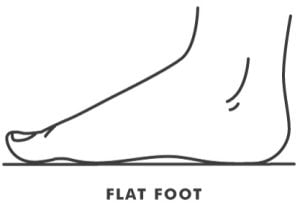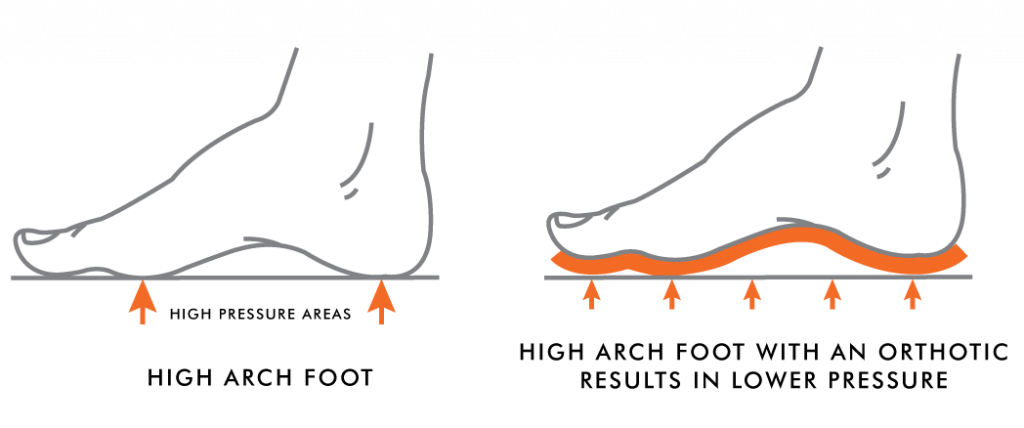High Arches vs Low Arches: The Benefits of Orthotics

Having flat feet is not necessarily a bad thing, though it does put you at more risk for some foot conditions such as plantar fasciitis and Achilles tendonitis.
But did you know high-arched feet are prone to similar problems too?
Let’s look at some general conditions each foot type is prone to, and how orthotics can benefit.
Metatarsalgia, Bunions & Calluses
Natural foot shape is in a tripod structure: leads to increased pressure on the ball of the foot and the heel.
It is not uncommon to see callus build up on the forefoot and heels, and bunion formation at the big toe joint.
Plantar Fasciitis
The plantar fascia is at a shorter position, and thus have more tension through it during weight bearing. Continuous excess strain can lead to wear and tear.
Achilles Tendinitis
A generally stiffer range of motion and tighter musculature, which results in a lack of pronation and shock absorption. There is a lot of impact build up in the lower limb joints to the lower back.
Rearfoot varus position: where the ankle is bowed alike the picture to the right, leading to more tension on the Achilles tendon. This also leads to a high chance of inversion ankle sprains where the ankle rolls outwards.
Knee Pain & Low Back Pain
Due to the same reasons that cause Achilles tendonitis, it is always recommended that physiotherapy/massage treatments and regular stretching is done in conjunction with orthotic treatment.
Orthotic treatment can improve pressure distribution and to provide cushioning, and also will help to unload the metatarsals.
Low Arch aka Pes planus

Achilles Tendonitis
Rearfoot valgum position during gait with overpronation, leading to increased strain on the Achilles tendon as there is a bowing effect, which can lead to Achilles tendonitis.
Plantar Fasciitis
Low arch structure puts the plantar fascia at consistent strain with weight bearing
Metatarsalgia, Bunions & Calluses
A flatter arch means the foot splays inward towards the centre of the body.
There is more pressure on the medial side of the first metatarsophalangeal joint, which can lead to bone calcification and callus build up.
Knee Pain & Back Pain
Due to increased overpronation (rolling in of the ankle), there are malalignment issues coming up the kinetic chain, as the knees and hips go through excess rotational forces
Can lead to knee problems such as patellofemoral pain syndrome, or chronic low back pain.
Orthotic treatment will provide arch support and help to realign the lower limbs.
Talk To An Expert!
This is not to say that all high and low arched feet will feel pain, even a fairly neutral foot may have pain as we have to consider other factors, such as activity level, work conditions, footwear, etc.
For orthotics to work to their full benefit, it is also important that they are paired with the proper footwear features for your foot type.
Feel free to drop by your nearest Kintec for more information on your feet and what we can do to help!
Mei Poon C.Ped(c)
Kintec Pedorthist



Magdalena
March 9, 2020 at 4:02 pmI live in Maple Ridge…. my age and high arch feet are really giving me problems…. can no longer just buy a shoe….I do have very good flip flops that even my Dr says are good for my feet and walking for a long time is no problem…… I need a walking shoe so I can get some exercise without REAL pain setting in after walking even short distances.. This site is a general site, I guess, and I do see particular stores advertising support for high arch shoes…. so, please advise.. It doesn’t have to be in Maple Ridge….anywhere in the lower mainland as long as they have knowledgeable staff and a variety of of shoes that would fit..
Michael Ryan
March 29, 2020 at 11:58 amHello Magdelena – My apologies for the delayed response. Completely understand the challenges with high arched feet in terms of adequate support. I understand that you may be experiencing pain during walking and we do have some shoes that may help accommodate your foot pain but we’d need some more information from you in order to provide the best advice. I would recommend taking advantage of our new free 15-min phone consultation appointment to speak to a clinician that can help steer you in the right direction. See their link here: Free Phone Consult. Hope that helps!
grahambarker
July 4, 2020 at 5:36 amThe issue can be described when there is a partial or complete collapse of the foot arch. There are mainly two terms associated with fallen arches, namely supination, and pronation. Visiting a reputed foot care center is the way to fix this issue with the right guidance.